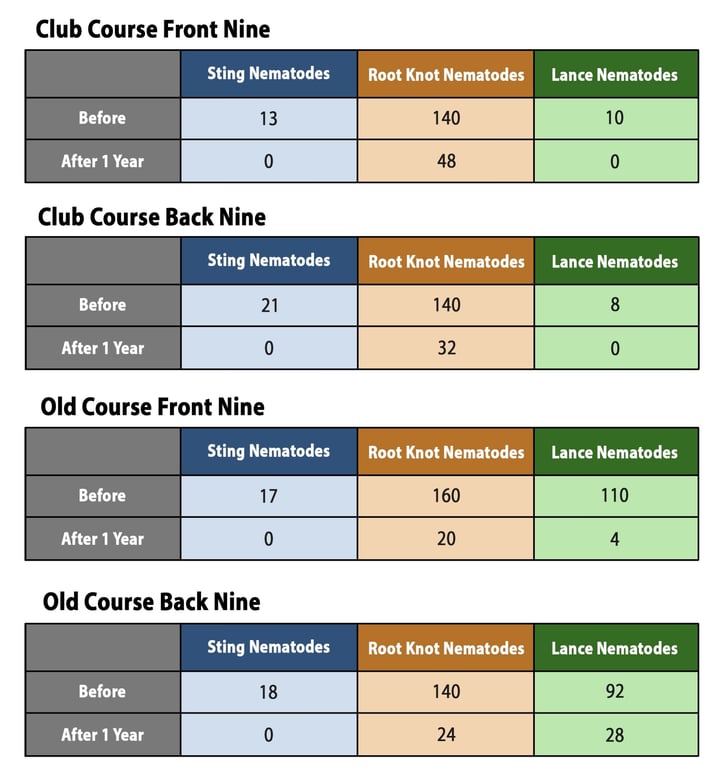It is often joked among scientists that nematodes can be found everywhere. About 90% of the ocean floor, and 80% of earth carries populations of nematodes. They are even rumored to be one of the first organisms to develop from a single-celled to a multi-celled organism.
Within the nematode family, there are both beneficial and parasitic organisms. On the one hand beneficial nematodes are important in mineralizing nutrients (converting nutrients into plant-useable forms), but on the other hand, parasitic nematodes can destroy root systems, cause disease, and negatively impact mycorrhizal fungi.
At Broken Sound Golf Club in Boca Raton, Florida, Director of Golf Maintenance and Environmental Consultant Shannon Easter has been in a constant battle to combat parasitic, root-feeding nematodes like sting, root-knot, and lance nematodes.
What are parasitic, root-feeding nematodes?
Parasitic, root-feeding nematodes attach themselves to and feed from plant root systems (see video of nematode feeding on root system below), causing a short, weak root system that ultimately limits the roots' ability to take up water and nutrients from the soil and causes the plant to wilt, become discolored and at times, die. A weakened root system can then inadvertently promote weed populations and disease.
How did Shannon Slay Nematode Populations?
“Sustainability is big at Broken Sound, so we’ve been looking for biological methods of controlling parasitic, root-feeding nematode populations,” says Shannon.
Over the past year, Shannon has been implementing an unnamed Holganix technology that is currently under development. “We’ve also added 20 pounds of carbon per 1,000 square feet.” When he underwent his latest soil analysis, which measures live counts of nematodes, he was shocked by the results.
Broken Sound has two courses, the “club course” and the “old course”. On both courses, Shannon had dramatic reductions in the live counts of sting, lance, and root-knot nematodes. Many of his nematode counts were considered “moderate to high risk” before using Holganix technology. Now, parasitic, nematode levels are down by 60% and at times as low as 0. 
“Before adding the Holganix technology and carbon to my program, I’d rate the course a 5 on a scale from 1-10, now, I’d rate the course a 9,” states Shannon. “It’s also saved us about $32,000.”
How does the unnamed Holganix technology help combat pathogenic nematodes?
Dr. Lambert at the University of Illinois who is conducting research at his facility explains that the Holganix technology is complex. “There’s a lot of things going on in the jug and it is difficult to state with certainty why Holganix technology is producing results.” However, Dr. Lambert does have three theories.
1. Affecting migration to the roots - Holganix technology appears to confuse or incapacitate the nematode so it can’t migrate to the plant and cause harm.
2. Inhibiting eggs from hatching - Holganix technology may be inhibiting soybean cyst nematode eggs from hatching.
3. Targeting pathogenic nematodes - Microbes in Holganix technology may be attacking pathogenic nematodes.
For additional information on Dr. Lambert's research, visit this blog: https://www.holganix.com/blog/preliminary-results-from-studies-on-pathogenic-nematodes-show-big-promise
Today, Holganix does not offer a registered nematicide product, and results on Holganix technology’s influence over pathogenic nematodes are still pending; however, the Holganix team is excited by the results seen at both Broken Sound and in a university setting and what those results could mean for the future of Holganix.
 |
February 18, 2016
|
3:31 PM
|
February 18, 2016
|
3:31 PM




-1.jpg)
-1.jpg)
-1.jpg)
.jpg)

.jpg)
.webp)
-1%20(1).webp)
-831535-2.webp)



.jpg)
.png)
.png)